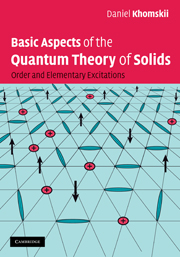Book contents
- Frontmatter
- Contents
- Foreword and general introduction
- 1 Some basic notions of classical and quantum statistical physics
- 2 General theory of phase transitions
- 3 Bose and Fermi statistics
- 4 Phonons in crystals
- 5 General Bose systems; Bose condensation
- 6 Magnetism
- 7 Electrons in metals
- 8 Interacting electrons. Green functions and Feynman diagrams (methods of field theory in many-particle physics)
- 9 Electrons with Coulomb interaction
- 10 Fermi-liquid theory and its possible generalizations
- 11 Instabilities and phase transitions in electronic systems
- 12 Strongly correlated electrons
- 13 Magnetic impurities in metals, Kondo effect, heavy fermions and mixed valence
- Bibliography
- Index
9 - Electrons with Coulomb interaction
Published online by Cambridge University Press: 05 June 2012
- Frontmatter
- Contents
- Foreword and general introduction
- 1 Some basic notions of classical and quantum statistical physics
- 2 General theory of phase transitions
- 3 Bose and Fermi statistics
- 4 Phonons in crystals
- 5 General Bose systems; Bose condensation
- 6 Magnetism
- 7 Electrons in metals
- 8 Interacting electrons. Green functions and Feynman diagrams (methods of field theory in many-particle physics)
- 9 Electrons with Coulomb interaction
- 10 Fermi-liquid theory and its possible generalizations
- 11 Instabilities and phase transitions in electronic systems
- 12 Strongly correlated electrons
- 13 Magnetic impurities in metals, Kondo effect, heavy fermions and mixed valence
- Bibliography
- Index
Summary
Using the techniques described in the previous chapter, we can in a unified way discuss properties of the electron gas with Coulomb interaction and consider such effects as optical response, screening, plasmons, etc. In many textbooks these properties are obtained using a variety of methods. The virtue of the Green function method is its universality and, I would say, not much simpler, but standardized form. This method permits one to obtain all the properties mentioned above in the form of one general expression, and it also gives the possibility to generalize the results quite easily to the cases of low-dimensional (1d, 2d) systems, or to take into account the details of the band structure of the material, etc. But more important is the fact that it leads naturally to a number of special interesting consequences which would be rather difficult to obtain with the usual classical methods. In this and in the next two chapters I will demonstrate how to reproduce, using this method, the familiar results such as Debye screening or the plasmon energy, but I will mostly concentrate on less frequently discussed effects which are quite naturally obtained using this technique.
Dielectric function, screening: random phase approximation
We start by studying the form of the effective electron–electron interaction in metals. The ordinary Coulomb interaction V(q) = 4πe2/q2 is modified by the reaction of the electronic system. The first, well-known effect is just the screening of the electric charge. But there are other interesting effects as well.
- Type
- Chapter
- Information
- Basic Aspects of the Quantum Theory of SolidsOrder and Elementary Excitations, pp. 159 - 174Publisher: Cambridge University PressPrint publication year: 2010



